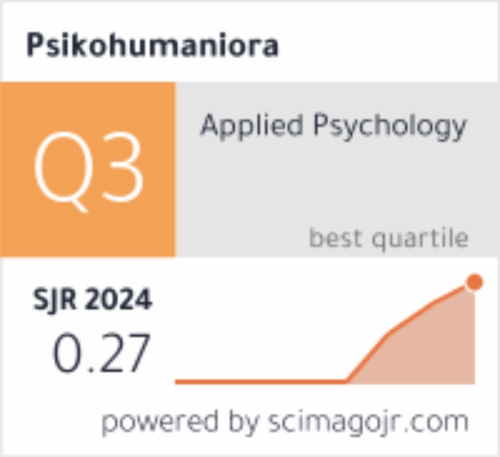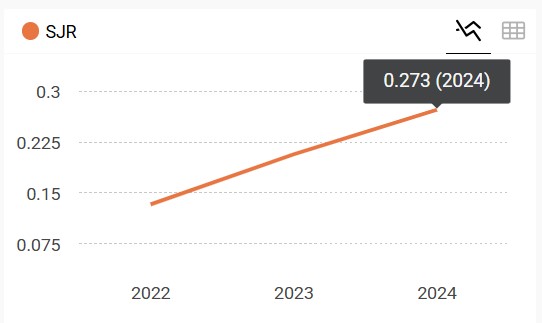Assessing adaptation of the psychometric properties of the General Health Questionnaire (GHQ-12) using the Rasch Measurement Model among Indian teenagers
DOI:
https://doi.org/10.21580/pjpp.v8i2.18077Keywords:
General Health Questionnaire, instrument validation, measuring tool validationAbstract
The General Health Questionnaire (GHQ-12) is widely accepted as an instrument used to examine diagnosable psychiatric disorders. It is also routinely used as a measure of psychological morbidity. This study aimed to assess and establish the psychometric properties of the GHQ-12 among Indian teenagers. The tool was administered to 212 adolescents aged from 12 to 18 years. Following two-stage cluster sampling, the data were collected from Aligarh district, India. Fleiss Kappa analysis was used to determine test reliability and showed an overall value of 0.94, based on the rater agreement for the instrument. Furthermore, the Rasch measurement model was used, with values of 0.79 and 0.83 for person and item reliability, respectively. Moreover, the value of unidimensionality was found to be 37.9%. Additionally, item fit statistics and item analysis were conducted for the instrument. Based on the preliminary data and findings, the study provides primary evidence for the reliability and validity of GHQ-12. Hence, the questionnaire can lead to more multi-site studies in India.
Downloads
References
Andrich, D., & Marais, I. (2019). A course in Rasch measurement theory: Measuring in the educational, social and health sciences (Vol. 41). Springer Nature Singapore. https://doi.org/10.1007/978-981-13-7496-8
Barry, M. M., Clarke, A. M., Jenkins, R., & Patel, V. (2013). A systematic review of the effectiveness of mental health promotion interventions for young people in low and middle income countries. BMC Public Health, 13(1), 835. https://doi.org/10.1186/1471-2458-13-835
Bond, T., & Fox, C. M. (2015). Applying the Rasch Model: Fundamental measurement in the human sciences. Routledge. https://doi.org/10.4324/9781315814698
Bor, W., Dean, A. J., Najman, J., & Hayatbakhsh, R. (2014). Are child and adolescent mental health problems increasing in the 21st century? A systematic review. Australian & New Zealand Journal of Psychiatry, 48(7), 606–616. https://doi.org/10.1177/0004867414533834
Chadda, R. (2018). Youth & mental health: Challenges ahead. Indian Journal of Medical Research, 148(4), 359–361. https://doi.org/10.4103/ijmr.IJMR_1585_18
Creed, F. (2023). Psychiatric disorders comorbid with general medical illnesses and functional somatic disorders: The Lifelines cohort study. Plos One, 18(5), e0286410. https://doi.org/10.1371/journal.pone.0286410
Daradkeh, T. K., Ghubash, R., & El-Rufaie, O. E. F. (2001). Reliability, validity, and factor structure of the Arabic version of the 12-item General Health Questionnaire. Psychological Reports, 89(1), 85–94. https://doi.org/10.2466/pr0.2001.89.1.85
Doi, Y., & Minowa, M. (2003). Factor structure of the 12‐item General Health Questionnaire in the Japanese general adult population. Psychiatry and Clinical Neurosciences, 57(4), 379–383. https://doi.org/10.1046/j.1440-1819.2003.01135.x
Fernandes, H. M., & Vasconcelos-Raposo, J. (2013). Factorial validity and invariance of the GHQ-12 among clinical and nonclinical samples. Assessment, 20(2), 219–229. https://doi.org/10.1177/1073191112465768
French, D. J., & Tait, R. J. (2004). Measurement invariance in the General Health Questionnaire-12 in young Australian adolescents. European Child & Adolescent Psychiatry, 13(1), 1–7. https://doi.org/10.1007/s00787-004-0345-7
Gao, F., Luo, N., Thumboo, J., Fones, C., Li, S.-C., & Cheung, Y.-B. (2004). Does the 12-item General Health Questionnaire contain multiple factors and do we need them? Health and Quality of Life Outcomes, 2(2), 63. https://doi.org/10.1186/1477-7525-2-63
Gisev, N., Bell, J. S., & Chen, T. F. (2013). Interrater agreement and interrater reliability: Key concepts, approaches, and applications. Research in Social and Administrative Pharmacy, 9(3), 330–338. https://doi.org/10.1016/j.sapharm.2012.04.004
Goldberg, D. P. (1972). The detection of psychiatric illness by questionnaire: A technique for the identification and assessment of non-psychotic psychiatric illness. Oxford University Press.
Goldberg, D. P., Gater, R., Sartorius, N., Ustun, T. B., Piccinelli, M., Gureje, O., & Rutter, C. (1997). The validity of two versions of the GHQ in the WHO study of mental illness in general health care. Psychological Medicine, 27(1), 191–197. https://doi.org/10.1017/S0033291796004242
Goldberg, D. P., & Hillier, V. F. (1979). A scaled version of the General Health Questionnaire. Psychological Medicine, 9(1), 139–145. https://doi.org/10.1017/S0033291700021644
Goldberg, D. P., & William, P. (1988). A user’s guide to the General Health Questionnaire. Nfer-Nelson.
Hahn, D., Reuter, K., & Härter, M. (2006). Screening for affective and anxiety disorders in medical patients - comparison of HADS, GHQ-12 and Brief-PHQ. Psycho-Social Medicine, 3, Doc09. http://www.ncbi.nlm.nih.gov/pubmed/19742274
Hankins, M. (2008a). The factor structure of the twelve item General Health Questionnaire (GHQ-12): the result of negative phrasing? Clinical Practice and Epidemiology in Mental Health, 4(1), 10. https://doi.org/10.1186/1745-0179-4-10
Hankins, M. (2008b). The reliability of the twelve-item general health questionnaire (GHQ-12) under realistic assumptions. BMC Public Health, 8(1), 355. https://doi.org/10.1186/1471-2458-8-355
Herrman, H., & Jané-Llopis, E. (2012). The status of mental health Promotion. Public Health Reviews, 34(2), 6. https://doi.org/10.1007/BF03391674
Jenkins, R., Baingana, F., Ahmad, R., McDaid, D., & Atun, R. (2011). Social, economic, human rights and political challenges to global mental health. Mental Health in Family Medicine, 8(2), 87–96. http://www.ncbi.nlm.nih.gov/pubmed/22654971
Kashyap, G. C., & Singh, S. K. (2017). Reliability and validity of general health questionnaire (GHQ-12) for male tannery workers: A study carried out in Kanpur, India. BMC Psychiatry, 17(1), 102. https://doi.org/10.1186/s12888-017-1253-y
Khan, A., Sriyanto, S., Baranovich, D. L., Tahir, L. M., Panatik, S. A., Sasmoko, S., Indrianti, Y., Hamid, M. A. A., Lukman, F., Van, N. T., & Jabor, M. K. (2023). The relationship between positive mental health, academic stress and suicide ideation among Malaysian adolescents residing in Johor Bahru. Current Psychology, 42(18), 15718–15726. https://doi.org/10.1007/s12144-022-02885-7
Latif, A. A. (2013). Pembangunan instrumen penilaian akhlak pelajar di institusi pengajian tinggi awam. [Doctoral dissertation]. Universiti Teknologi Malaysia.
Linacre, J. M. (2005). Standard errors: Means, measures, origins and anchor values. Rasch Measurement Transactions: Archives of the Rasch Measurement SIG, AERA, 19(3), 1030. https://www.rasch.org/rmt/rmt193e.htm
López-Castedo, A., & Fernández, L. (2005). Psychometric properties of the Spanish version of the 12-Item General Health Questionnaire in adolescents. Perceptual and Motor Skills, 100(3), 676–680. https://doi.org/10.2466/pms.100.3.676-680
Mangal, A., Thakur, A., Nimavat, K., Dabar, D., & Yadav, S. (2020). Screening for common mental health problems and their determinants among school-going adolescent girls in Gujarat, India. Journal of Family Medicine and Primary Care, 9(1), 264. https://doi.org/10.4103/jfmpc.jfmpc_732_19
Martin, A. J. (1999). Assessing the multidimensionality of the 12-item General Health Questionnaire. Psychological Reports, 84(3), 927–935. https://doi.org/10.2466/pr0.1999.84.3.927
Martin, C. R., & Jomeen, J. (2003). Is the 12-item General Health Questionnaire (GHQ-12) confounded by scoring method during pregnancy and following birth? Journal of Reproductive and Infant Psychology, 21(4), 267–278. https://doi.org/10.1080/02646830310001622088
Martin, C. R., & Newell, R. J. (2005). Is the 12-item General Health Questionnaire (GHQ-12) confounded by scoring method in individuals with facial disfigurement? Psychology & Health, 20(5), 651–659. https://doi.org/10.1080/14768320500060061
Masters, G. N. (1982). A rasch model for partial credit scoring. Psychometrika, 47(2), 149–174. https://doi.org/10.1007/BF02296272
McHugh, M. L. (2012). Interrater reliability: The Kappa statistic. Biochemia Medica, 22(3), 276–282. http://www.ncbi.nlm.nih.gov/pubmed/23092060
Mohanan, P., Jain, A., Shashidhar Kotian, M., & Vinay, N. K. (2012). Are the Anganwadi workers healthy and happy? A cross sectional study using the General Health Questionnaire (GHQ 12) at Mangalore, India. Journal of Clinical & Diagnostic Research, 6(7), 1151–1154. https://doi.org/10.7860/JCDR/2012/.2464
Navarro, P., Ascaso, C., Garcia-Esteve, L., Aguado, J., Torres, A., & Martín-Santos, R. (2007). Postnatal psychiatric morbidity: A validation study of the GHQ-12 and the EPDS as screening tools. General Hospital Psychiatry, 29(1), 1–7. https://doi.org/10.1016/j.genhosppsych.2006.10.004
Patton, G. C., Sawyer, S. M., Santelli, J. S., Ross, D. A., Afifi, R., Allen, N. B., Arora, M., Azzopardi, P., Baldwin, W., Bonell, C., Kakuma, R., Kennedy, E., Mahon, J., McGovern, T., Mokdad, A. H., Patel, V., Petroni, S., Reavley, N., Taiwo, K., … Viner, R. M. (2016). Our future: A Lancet commission on adolescent health and wellbeing. The Lancet, 387(10036), 2423–2478. https://doi.org/10.1016/S0140-6736(16)00579-1
Piccinelli, M., Bisoffi, G., Bon, M. G., Cunico, L., & Tansella, M. (1993). Validity and test-retest reliability of the italian version of the 12-item General Health Questionnaire in general practice: A comparison between three scoring methods. Comprehensive Psychiatry, 34(3), 198–205. https://doi.org/10.1016/0010-440X(93)90048-9
Polanczyk, G. V., Salum, G. A., Sugaya, L. S., Caye, A., & Rohde, L. A. (2015). Annual research review: A meta‐analysis of the worldwide prevalence of mental disorders in children and adolescents. Journal of Child Psychology and Psychiatry, 56(3), 345–365. https://doi.org/10.1111/jcpp.12381
Politi, P. L., Piccinelli, M., & Wilkinson, G. (1994). Reliability, validity and factor structure of the 12‐item General Health Questionnaire among young males in Italy. Acta Psychiatrica Scandinavica, 90(6), 432–437. https://doi.org/10.1111/j.1600-0447.1994.tb01620.x
Quek, K. F., Low, W. Y., Razack, A. H., & Loh, C. S. (2001). Reliability and validity of the General Health Questionnaire (GHQ‐12) among urological patients: A Malaysian study. Psychiatry and Clinical Neurosciences, 55(5), 509–513. https://doi.org/10.1046/j.1440-1819.2001.00897.x
Rasch, G. (1960). Probabilistic models for some intelligence and attainment tests. In Studies in mathematical psychology. Danmarks Paedagogiske Institut.
Reckase, M. D. (1979). Unifactor latent Trait Models applied to multifactor tests: Results and implications. Journal of Educational Statistics, 4(3), 207–230. https://doi.org/10.3102/10769986004003207
Rey, J. J., Abad, F. J., Barrada, J. R., Garrido, L. E., & Ponsoda, V. (2014). The impact of ambiguous response categories on the factor structure of the GHQ–12. Psychological Assessment, 26(3), 1021–1030. https://doi.org/10.1037/a0036468
Schrnitz, N., Kruse, J., & Tress, W. (1999). Psychometric properties of the General Health Questionnaire (GHQ‐12) in a German primary care sample. Acta Psychiatrica Scandinavica, 100(6), 462–468. https://doi.org/10.1111/j.1600-0447.1999.tb10898.x
Shevlin, M., & Adamson, G. (2005). Alternative factor models and factorial invariance of the GHQ-12: A large sample analysis using Confirmatory Factor Analysis. Psychological Assessment, 17(2), 231–236. https://doi.org/10.1037/1040-3590.17.2.231
Smith, A. B., Fallowfield, L. J., Stark, D. P., Velikova, G., & Jenkins, V. (2010). A Rasch and confirmatory factor analysis of the General Health Questionnaire (GHQ) - 12. Health and Quality of Life Outcomes, 8(1), 45. https://doi.org/10.1186/1477-7525-8-45
Souza, M. A. P., Coster, W. J., Mancini, M. C., Dutra, F. C. M. S., Kramer, J., & Sampaio, R. F. (2017). Rasch analysis of the Participation scale (P-scale): usefulness of the P-scale to a rehabilitation services network. BMC Public Health, 17(1), 934. https://doi.org/10.1186/s12889-017-4945-9
Sumintono, B., & Widhiarso, W. (2015). Aplikasi Pemodelan Rasch pada assessment pendidikan. Trim Komunikata.
UNICEF. (2023, May). Adolescents: Investing in a safe, healthy and productive transition from childhood to adulthood is critical. UNICEF. https://data.unicef.org/topic/adolescents/overview/
Werneke, U., Goldberg, D. P., Yalcin, I., & Üstün, B. T. (2000). The stability of the factor structure of the General Health Questionnaire. Psychological Medicine, 30(4), S0033291799002287. https://doi.org/10.1017/S0033291799002287
Downloads
Published
How to Cite
Issue
Section
License
The copyright of the accepted article shall be assigned to the publisher of the journal. The intended copyright includes the right to publish the article in various forms (including reprints). The journal maintains the publishing rights to published articles.
In line with the license, authors and any users (readers and other researchers) are allowed to share and adapt the material only for non-commercial purposes. In addition, the material must be given appropriate credit, provided with a link to the license, and indicated if changes were made. If authors remix, transform, or build upon the material, authors must distribute their contributions under the same license as the original.



